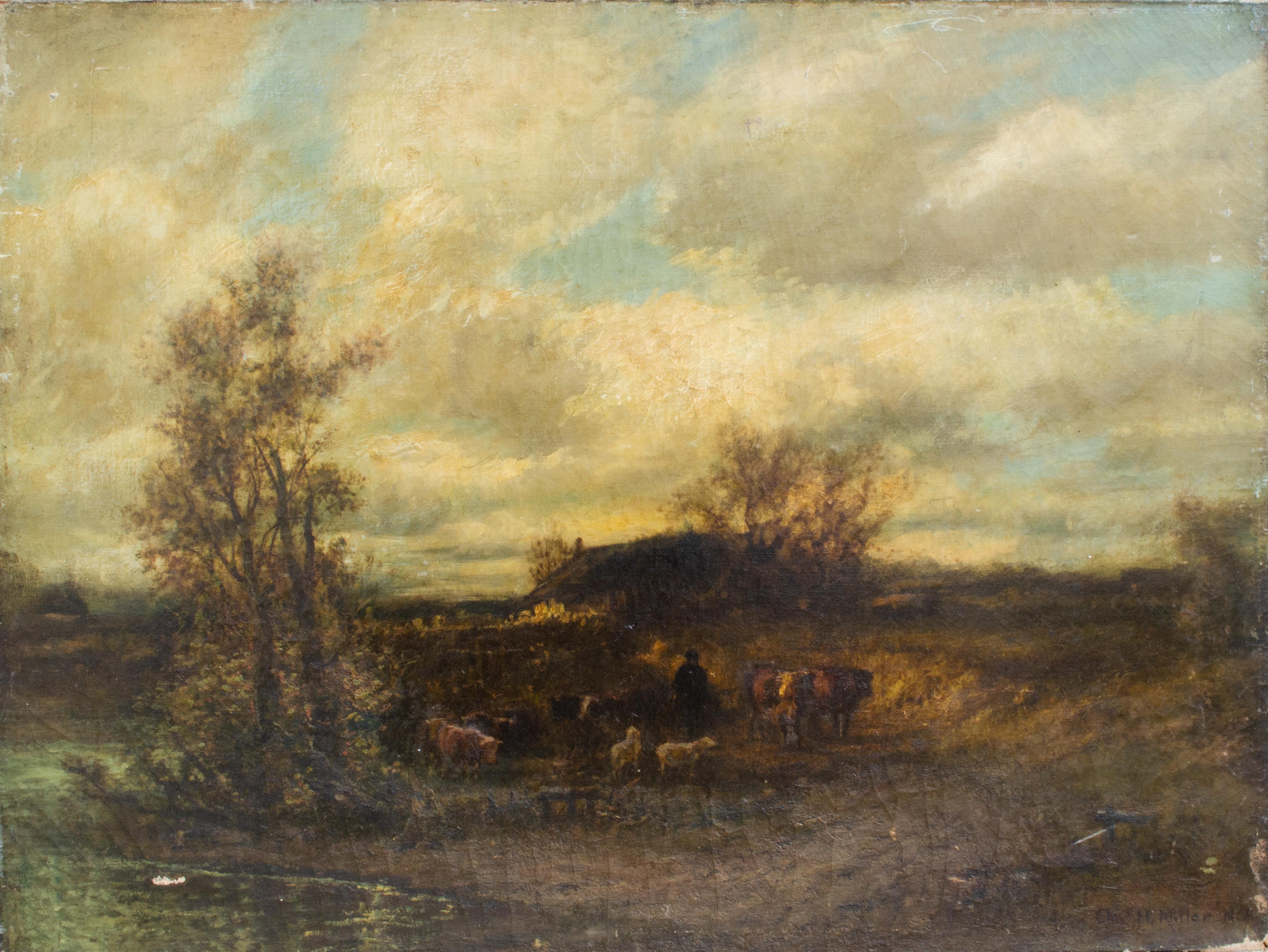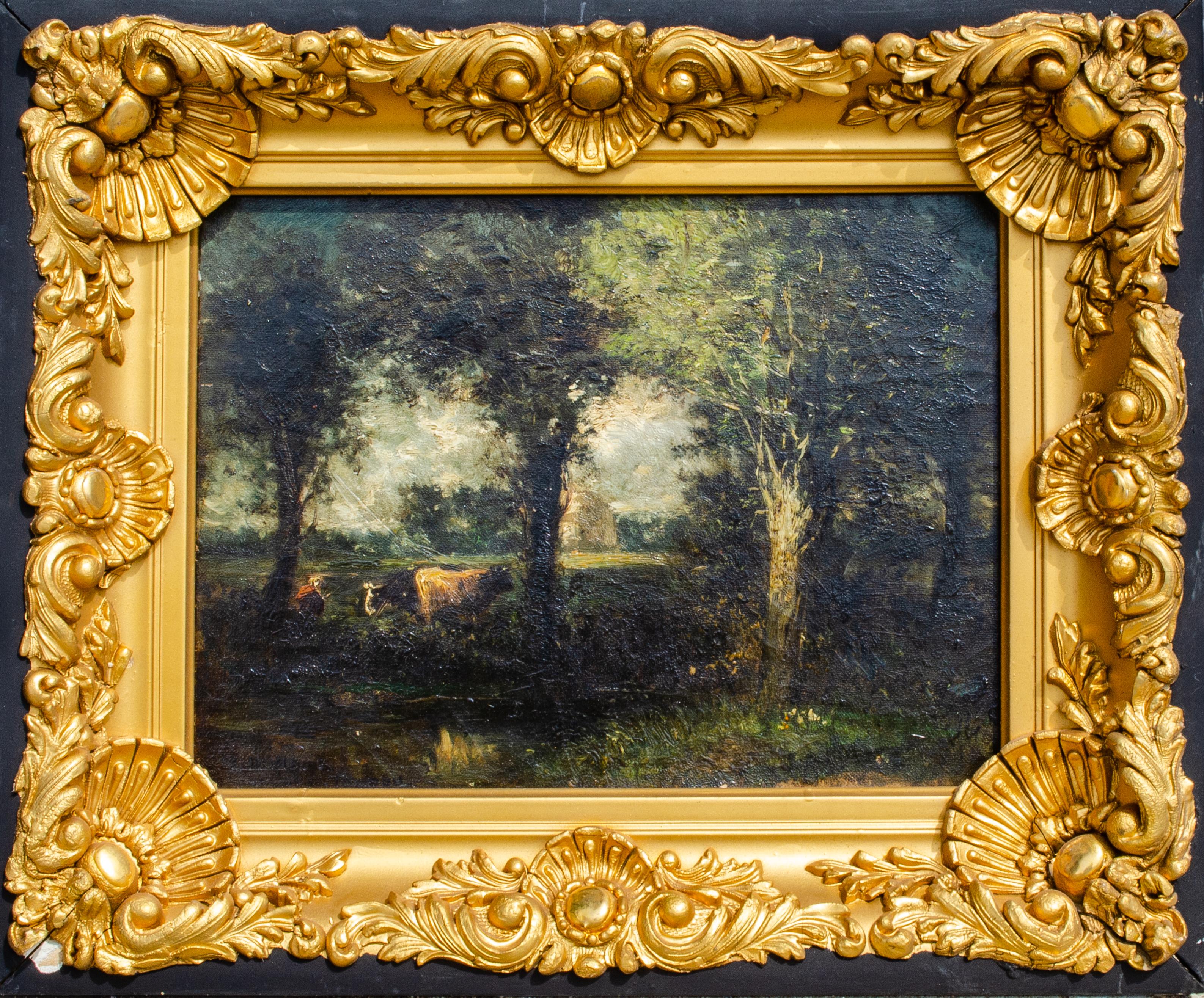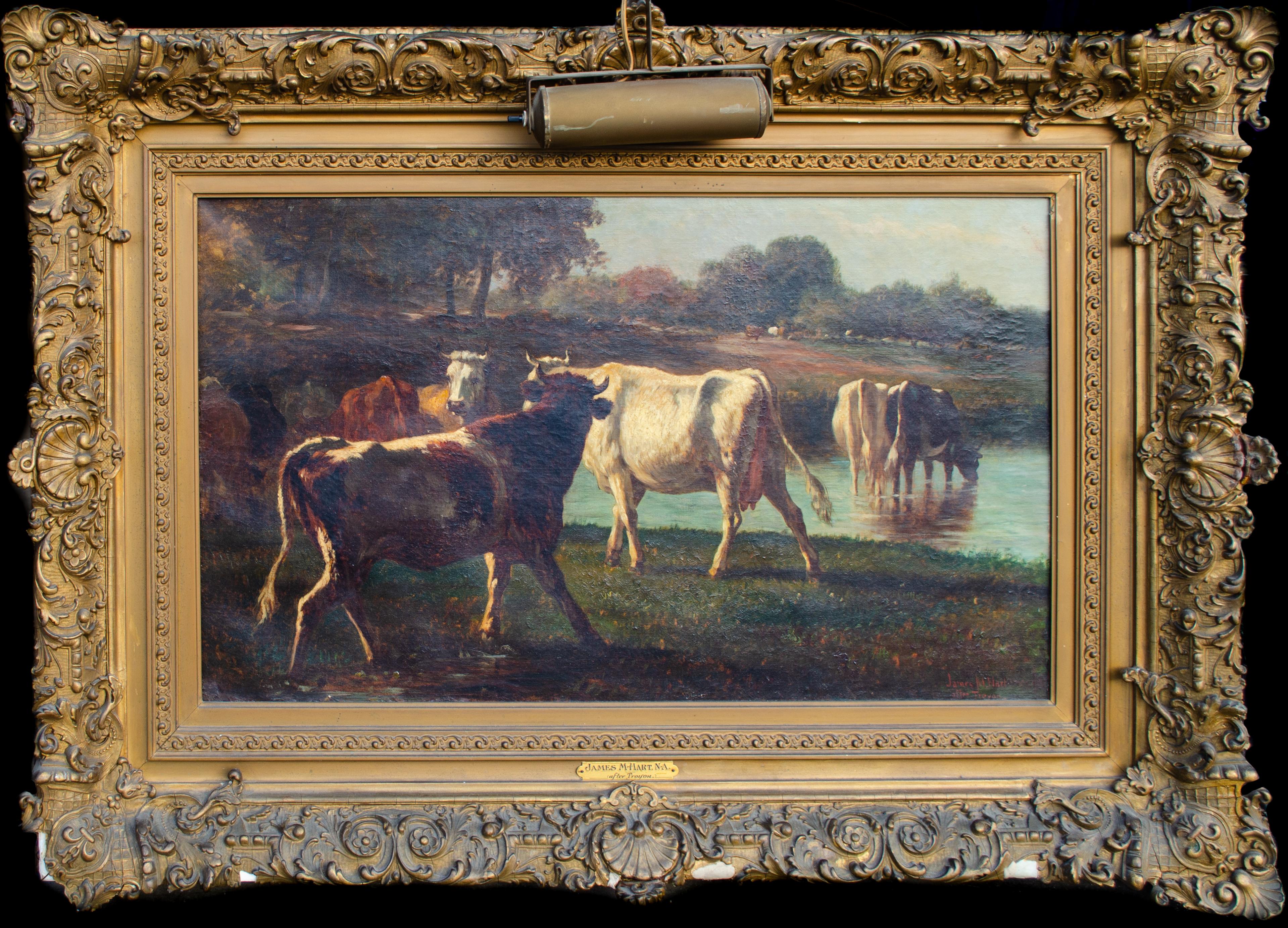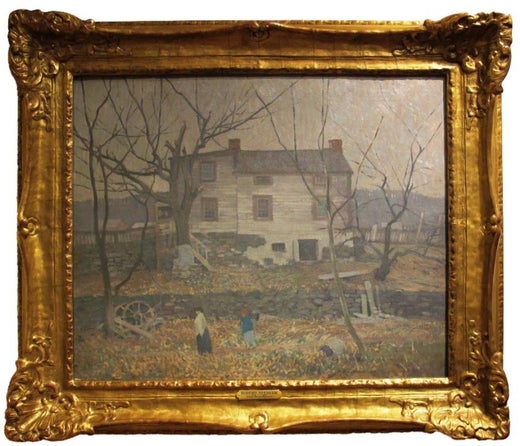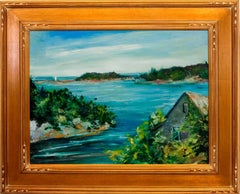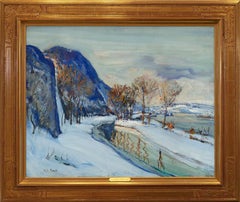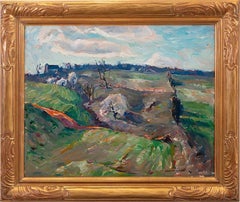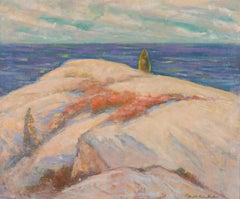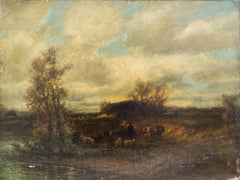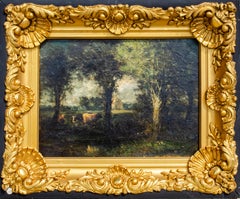Items Similar to "The Gray House"
Want more images or videos?
Request additional images or videos from the seller
1 of 6
Robert Spencer"The Gray House"Circa 1910
Circa 1910
About the Item
Jim’s of Lambertville is proud to offer this artwork by:
Robert Spencer (1879 - 1931)
One of the rarest and most important artists among the New Hope School, Robert Spencer was born in Harvard, Nebraska. Living an itinerant lifestyle as a youth, Spencer ended up in New York by his teenage years. After graduating high school, he attended classes at the National Academy of Design in New York in 1899. From 1903 to 1905, he continued his studies at the New York School of Art under William Merritt Chase and Robert Henri.
From 1906 through 1910, Spencer lived in towns in close proximity to the Delaware River, such as Frenchtown, New Jersey and Point Pleasant, Pennsylvania. He spent the summer of 1909 studying with Daniel Garber at his home in Lumberville. Soon after, Spencer moved to New Hope, where for the sake of conserving money, he roomed with fellow artist Charles Ramsey. The two impoverished artists rented the dilapidated old Huffnagle Mansion for two dollars a month. It was there that Spencer’s career would begin to take shape. His studio was set up in the massive ballroom just a stone’s throw away from the Heath and Maris mills. The mansion was originally built for Richard Heath in 1707, who at the time owned the Heath Grist Mill. It was later bought by William Maris in 1802, who owned the Maris Silk Mill. These two mills provided subject matter for some of Spencer’s most important paintings and elements from them continued to appear in his paintings for year after. Spencer became famous for his scenes of mills, tenements, and factories. One of his most praised depictions of working-class life is “Repairing the Bridge”, which was purchased by the Metropolitan Museum of Art in 1914.
In 1913, Spencer met Margaret Fulton, an artist and architect, and niece of well-known landscape painter, Birge Harrison. At the time, Margaret was studying with William Lathrop at his Phillips Mill home where Spencer often visited. A relationship developed and they married in 1914. For a while after, the Spencers moved across the river to nearby Lambertville, where they lived above the firehouse. In 1916, they bought a home in Rabbit Run, midway between New Hope and Phillips Mill where Spencer remained until his untimely death. In 1931, Robert Spencer, suffering from bouts of depression and an unhealthy marriage, took his own life.
Spencer exhibited extensively in the United States and abroad, garnering numerous prizes, including the Hallgarten Prize, the Inness Award, and the Gold Medal from the Pennsylvania Academy of the Fine Arts.
His work is in the permanent collections of the Art Institute of Chicago, the Metropolitan Museum of Art, the James A. Michener Art Museum, the Brooklyn Museum, the Smithsonian Institute, the Corcoran Gallery of Art, the Philadelphia Museum of Art, the National Academy of Design, the Reading Public Museum, the Detroit Institute of Fine Arts, the National Arts Club, the Delaware Art Museum, and the Phillips Collection in Washington, D.C., among others.
- Creator:Robert Spencer (1879-1931, American)
- Creation Year:Circa 1910
- Dimensions:Height: 35 in (88.9 cm)Width: 40 in (101.6 cm)Depth: 4 in (10.16 cm)
- More Editions & Sizes:Frame Size 34" x 39" x 4.5"Price: $231,250
- Medium:
- Movement & Style:
- Period:
- Condition:
- Gallery Location:Lambertville, NJ
- Reference Number:Seller: JOL042118011stDibs: LU3743590992
Robert Spencer
Biography from Anderson Galleries Photo of Robert Spencer Robert Spencer was born in 1879 in Nebraska, the son of a Swedenborgian minister. After studying medicine briefly, he decided to become an artist and moved to New York City, where he enrolled at the National Academy of Design. Later he studied with William Merritt Chase and Robert Henri at the New York School of Art. He moved to New Hope, Bucks County in 1906, and studied privately with the well-known Bucks County painter Daniel Garber. It was at the home of painter William L. Lathrop that Spencer met his future wife, Margaret Fulton, herself an accomplished architect. For the next 25 years Spencer lived and worked in Bucks County, becoming one of the most prominent members of the Pennsylvania Impressionist art colony. He suffered several nervous breakdowns in the 1920s, and in 1931 took his own life. Spencer became one of the most visible artists in the New York art world in the teens. His first success came in 1914, when the Metropolitan Museum of Art purchased one of his major early canvases, "Repairing the Bridge". The celebrated collector Duncan Phillips then took an interest in Spencer's work, eventually purchasing eight of Spencer's canvases, currently housed in the Phillips Collection in Washington, DC. The two men became friends, and Phillips appointed Spencer to the Committee on Scope and Plan of the new gallery then being created by Phillips. After Spencer's death, Phillips praised Spencer as "a rebel always against the standardized and stereotyped in art." Phillips believed that "there [was] no other painter, not John Sloan or Edward Hopper, more pungently American in expression." Spencer also has work in the collections of the Brooklyn Museum, the Carnegie Institute, the Corcoran Gallery of Art, and the Detroit Institute of the Arts. In 1915, he won a gold medal at the prestigious Panama-Pacific International Exposition in San Francisco. Stylistically, Spencer differed radically from most of his Pennsylvania Impressionist colleagues. Probably influenced by Henri and the Ashcan School, Spencer made his reputation with skillful, evocative renderings of the everyday life of his community, often depicting the mills, tenements, and factories of New Hope and surrounding areas. "A landscape without a building or a figure, " he said, " is a very lonely picture to me." Later Spencer painted more fanciful European scenes, many of which he did from his imagination, since he did not actually travel to Europe until 1925. Spencer's painting "Mountebanks and Thieves" won a prize at the 1926 Carnegie International Exhibition in Pittsburgh, and juror Pierre Bonnard said, "Mr. Spencer . . . is in the full vigor of his talent which is great. His art does not resemble European art, a rare fact in America."
About the Seller
5.0
Vetted Professional Seller
Every seller passes strict standards for authenticity and reliability
Established in 1997
1stDibs seller since 2014
38 sales on 1stDibs
Typical response time: Several days
- ShippingRetrieving quote...Shipping from: Lambertville, NJ
- Return Policy
Authenticity Guarantee
In the unlikely event there’s an issue with an item’s authenticity, contact us within 1 year for a full refund. DetailsMoney-Back Guarantee
If your item is not as described, is damaged in transit, or does not arrive, contact us within 7 days for a full refund. Details24-Hour Cancellation
You have a 24-hour grace period in which to reconsider your purchase, with no questions asked.Vetted Professional Sellers
Our world-class sellers must adhere to strict standards for service and quality, maintaining the integrity of our listings.Price-Match Guarantee
If you find that a seller listed the same item for a lower price elsewhere, we’ll match it.Trusted Global Delivery
Our best-in-class carrier network provides specialized shipping options worldwide, including custom delivery.More From This Seller
View All"Arrival of Spring"
By Evelyn Faherty
Located in Lambertville, NJ
Jim’s of Lambertville is proud to offer this artwork.
Signed lower right.
Evelyn Faherty (1919-2015)
Evelyn Faherty was born in the early 20th century and made her home in Yardl...
Category
21st Century and Contemporary American Impressionist Landscape Paintings
Materials
Oil, Canvas
"House on the Harbor"
By Evelyn Faherty
Located in Lambertville, NJ
Jim’s of Lambertville is proud to offer this artwork.
Signed lower right.
Evelyn Faherty (1919-2015)
Evelyn Faherty was born in the early 20th century and made her home in Yardl...
Category
20th Century American Impressionist Landscape Paintings
Materials
Oil, Canvas
"The Narrows"
By Walter Emerson Baum
Located in Lambertville, NJ
Jim’s of Lambertville Fine Art Gallery is proud to present this piece by Walter Emerson Baum (1884 - 1956).
Born in Sellersville, Pennsylvania, Walter Baum was one of the only membe...
Category
1930s American Impressionist Landscape Paintings
Materials
Canvas, Oil
"Solebury Spring"
By John Fulton Folinsbee
Located in Lambertville, NJ
Jim's of Lambertville Fine Art Gallery is proud to present this piece by John Fulton Folinsbee (1892 - 1972).
One of the finest painters to embark upon the New Hope Art Colony, John...
Category
1930s American Impressionist Landscape Paintings
Materials
Canvas, Oil
"Perkiomen Mills"
By Walter Emerson Baum
Located in Lambertville, NJ
Jim’s of Lambertville Fine Art Gallery is proud to present this piece by Walter Emerson Baum (1884 - 1956).
Born in Sellersville, Pennsylvania, Walter Baum was one of the only membe...
Category
1930s American Impressionist Landscape Paintings
Materials
Canvas, Oil
"Winter Greetings"
By Alexander Farnham
Located in Lambertville, NJ
Jim’s of Lambertville is proud to offer this artwork.
Signed lower left.
Complemented by a hand carved and gilt frame.
Alexander Farnham (1926 - 2017)
Alexander Farnham studied with Anne Steele Marsh, Van Deering Perrine, and at the Art Students League with George Bridgman...
Category
20th Century American Impressionist Landscape Paintings
Materials
Oil, Canvas
You May Also Like
Au Revoir October
Located in Boston, MA
Signed lower right: “Beatrice Whitney Van Ness”. From the estate of the artist.
Beatrice Whitney Van Ness, acclaimed painter and art educato...
Category
Mid-20th Century American Impressionist Landscape Paintings
Materials
Canvas, Oil
Long Island Impressionist Pasture Scene by C.H. Miller
By Charles Henry Miller
Located in New York, NY
Charles Henry Miller (American, 1842-1922)
The Road and The Ridge, c. late 1800s-early 1900s
Oil on canvas
24 x 32 in.
Signed lower left: Cha. H. Miller
Inscribed verso: "The Road and The Ridge"
Charles Henry Miller was a noted artist and painter of landscapes from Long Island, New York. The American poet Bayard Taylor called him, "The artistic discoverer of the little continent of Long Island."
Miller was educated at Mount Washington Collegiate Institute, and graduated in medicine at the New York Homeopathic Institute in 1864. Before his graduation, he had occasionally painted pictures, and in 1860 he exhibited The Challenge Accepted at the National Academy of Design, in New York City.
He lived in Queens at the summer estate, Queenslawn, originally purchased by his parents. He went abroad in 1864 and again in 1867, and was a pupil in the Bavarian Royal Academy at Munich under the instruction of Adolf Lier...
Category
Early 20th Century American Impressionist Landscape Paintings
Materials
Canvas, Oil
Style of Troyon Impressionist Painting by C.H. Miller
By Charles Henry Miller
Located in New York, NY
Charles Henry Miller (American, 1842-1922)
Untitled (After Troyon), c, 1885
Oil on canvas
9 x 12 in.
Framed: 14 x 17 x 3 1/2 in.
Signed lower left, inscribed verso
Charles Henry Miller was a noted artist and painter of landscapes from Long Island, New York. The American poet Bayard Taylor called him, "The artistic discoverer of the little continent of Long Island."
Miller was educated at Mount Washington Collegiate Institute, and graduated in medicine at the New York Homeopathic Institute in 1864. Before his graduation, he had occasionally painted pictures, and in 1860 he exhibited The Challenge Accepted at the National Academy of Design, in New York City.
He lived in Queens at the summer estate, Queenslawn, originally purchased by his parents. He went abroad in 1864 and again in 1867, and was a pupil in the Bavarian Royal Academy at Munich under the instruction of Adolf Lier...
Category
1880s American Impressionist Landscape Paintings
Materials
Oil, Canvas
Charles Henry Miller Hudson River School landscape of Queens, NY
By Charles Henry Miller
Located in New York, NY
Charles Henry Miller (American, 1842-1922)
Untitled, c. Late 1800s-Early 1900s
Oil on board
9 x 12 in.
Framed: 14 5/8 x 17 3/4 in.
Signed lower right: C.H. Miller
Charles Henry Miller was a noted artist and painter of landscapes from Long Island, New York. The American poet Bayard Taylor called him, "The artistic discoverer of the little continent of Long Island."
Miller was educated at Mount Washington Collegiate Institute, and graduated in medicine at the New York Homeopathic Institute in 1864. Before his graduation, he had occasionally painted pictures, and in 1860 he exhibited The Challenge Accepted at the National Academy of Design, in New York City.
He lived in Queens at the summer estate, Queenslawn, originally purchased by his parents. He went abroad in 1864 and again in 1867, and was a pupil in the Bavarian Royal Academy at Munich under the instruction of Adolf Lier.
After the 1874 death of his father, Jacob Miller, who was a wealthy architect and builder, Miller received a large inheritance that allowed him to paint as an independent artist for the remainder of his long life. He worked seriously and exhibited regularly, including at international exhibitions.
The majority of his oil paintings depict Long Island subjects, especially those in and around Queens Village. Fed up with the development of the eastern part of Queens (present-day Nassau County), he began to spend part of his summers in East Marion, Long Island, c. 1910. Here he spent his time sketching and painting the surrounding areas.
In 1885 he published The Philosophy of Art in America, using the pseudonym Carl De Muldor (he was descended from the De Muldor family).
His work was recognized: in 1873, he was elected an associate of the National Academy of Design and an academician in 1875. He served as president of the New York Art Club in 1879 and of the American Committee at the Munich International Exposition in 1883.
Legacy and honors
• In 1910 Miller founded the Queens Borough Allied Arts & Crafts Society.
• A New York City public school, Queens P.S. 33, was once named for him.
• 1878, gold medal awarded by the Massachusetts Charitable Association
• 1885, gold medal at the World's Exposition in New Orleans.
Following is a list, which includes many of his known exhibitions:
• National Academy of Design, New York, NY, 1860-61, 1865-67, 1870-1921
• Brooklyn Art Association, Brooklyn, NY, 1872-84, 1891-92
• Artist's Fund Society, New York, NY, 1874 (exhibition & sale), 1886 (exhibition & sale)
• Century Association, New York, NY, (1874-1917)
• Philadelphia Centennial Exhibition, Philadelphia, PA, 1876 (prize)
• Society of American Artists, New York, NY, (1878-1882)
• Massachusetts Charitable Mechanic Association, Boston, MA, 1878 (prize)
• Paris International Exposition, Paris, France, 1878, 1889
• American Water Color Society Exhibition, New York, NY, 1879
• Pennsylvania Academy of Fine Arts, Philadelphia , PA, 1879-99
• Boston Art Club, Boston, MA, 1880-1907 (prize)
• Union League Club, New York, NY, 1880
• Lotos Club, New York, NY, 1880, 1896, 1899-1900, 1906
• Salons of Paris, Paris, France, 1882
• International Exhibition, Munich, Germany, 1883 (president & exhibitor)
• New Orleans Exposition, New Orleans, LA, 1885 (prize)
• Art Institute of Chicago, Chicago, IL, 1888-89, 1891, 1894-98, 1904
• Fifth Avenue Art Gallery, New York, NY, 1889 (exhibition & sale)
• World's Columbian Exposition, Chicago, IL, 1892
• Frederick A. Chapman Gallery, New York, NY, 1898 (solo)
• Miller Studio...
Category
Early 20th Century American Impressionist Landscape Paintings
Materials
Canvas, Foam, Oil
Charles Henry Miller Impressionist Landscape Oil Painting
By Charles Henry Miller
Located in New York, NY
Charles Henry Miller (American, 1842-1922)
Untitled (New York Landscape), c. 1900
Oil on canvas laid on foam
6 1/8 x 10 5/8 in.
Signed lower left: C.H.M.
Charles Henry Miller was a noted artist and painter of landscapes from Long Island, New York. The American poet Bayard Taylor called him, "The artistic discoverer of the little continent of Long Island."
Miller was educated at Mount Washington Collegiate Institute, and graduated in medicine at the New York Homeopathic Institute in 1864. Before his graduation, he had occasionally painted pictures, and in 1860 he exhibited The Challenge Accepted at the National Academy of Design, in New York City.
He lived in Queens at the summer estate, Queenslawn, originally purchased by his parents. He went abroad in 1864 and again in 1867, and was a pupil in the Bavarian Royal Academy at Munich under the instruction of Adolf Lier.
After the 1874 death of his father, Jacob Miller, who was a wealthy architect and builder, Miller received a large inheritance that allowed him to paint as an independent artist for the remainder of his long life. He worked seriously and exhibited regularly, including at international exhibitions.
The majority of his oil paintings depict Long Island subjects, especially those in and around Queens Village. Fed up with the development of the eastern part of Queens (present-day Nassau County), he began to spend part of his summers in East Marion, Long Island, c. 1910. Here he spent his time sketching and painting the surrounding areas.
In 1885 he published The Philosophy of Art in America, using the pseudonym Carl De Muldor (he was descended from the De Muldor family).
His work was recognized: in 1873, he was elected an associate of the National Academy of Design and an academician in 1875. He served as president of the New York Art Club in 1879 and of the American Committee at the Munich International Exposition in 1883.
Legacy and honors
• In 1910 Miller founded the Queens Borough Allied Arts & Crafts Society.
• A New York City public school, Queens P.S. 33, was once named for him.
• 1878, gold medal awarded by the Massachusetts Charitable Association
• 1885, gold medal at the World's Exposition in New Orleans.
Following is a list, which includes many of his known exhibitions:
• National Academy of Design, New York, NY, 1860-61, 1865-67, 1870-1921
• Brooklyn Art Association, Brooklyn, NY, 1872-84, 1891-92
• Artist's Fund Society, New York, NY, 1874 (exhibition & sale), 1886 (exhibition & sale)
• Century Association, New York, NY, (1874-1917)
• Philadelphia Centennial Exhibition, Philadelphia, PA, 1876 (prize)
• Society of American Artists, New York, NY, (1878-1882)
• Massachusetts Charitable Mechanic Association, Boston, MA, 1878 (prize)
• Paris International Exposition, Paris, France, 1878, 1889
• American Water Color Society Exhibition, New York, NY, 1879
• Pennsylvania Academy of Fine Arts, Philadelphia , PA, 1879-99
• Boston Art Club, Boston, MA, 1880-1907 (prize)
• Union League Club, New York, NY, 1880
• Lotos Club, New York, NY, 1880, 1896, 1899-1900, 1906
• Salons of Paris, Paris, France, 1882
• International Exhibition, Munich, Germany, 1883 (president & exhibitor)
• New Orleans Exposition, New Orleans, LA, 1885 (prize)
• Art Institute of Chicago, Chicago, IL, 1888-89, 1891, 1894-98, 1904
• Fifth Avenue Art Gallery, New York, NY, 1889 (exhibition & sale)
• World's Columbian Exposition, Chicago, IL, 1892
• Frederick A. Chapman Gallery, New York, NY, 1898 (solo)
• Miller Studio...
Category
Early 20th Century American Impressionist Landscape Paintings
Materials
Canvas, Foam, Oil
Original James M. Hart
Located in New York, NY
James MacDougal Hart (American, 1828-1901)
Untitled (After Troyon), 19th century
Oil on canvas
18 1/16 x 30 1/16 in.
Framed: 31 1/2 x 40 1/2 in.
Signed lower right: James M Hart...
Category
19th Century American Impressionist Landscape Paintings
Materials
Canvas, Oil

